Project Overview
Information Products
Commodities
- Agronomic: sorghum (sweet)
Practices
- Animal Production: feed/forage
- Crop Production: crop improvement and selection, varieties and cultivars
- Education and Training: demonstration, farmer to farmer, mentoring, networking
- Farm Business Management: cooperatives, farmers' markets/farm stands, value added
- Sustainable Communities: local and regional food systems, new business opportunities
Summary:
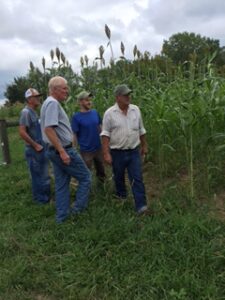 This project attempts to reintroduce sweet sorghum as a profitable crop for small scale farms in northern Indiana. Our challenges include: 1) determining the optimal variety(ies) of sweet sorghum for production in northern Indiana climate; 2) developing a cooperative approach to planting, cultivating, harvesting, syrup production to increase profitability on small plots and to improve the quality of life for the farmer, as cultivation and harvest/processing can be very labor-intensive; 3) reintroducing sweet sorghum to local markets such as farmers markets, restaurants and breweries; and 4) sharing knowledge with other small farmers so that this "local sugar" product is not lost to future generations. Over two years, four small farming operations attempt to meet these challenges in order to reintroduce sweet sorghum to a new generation of producers and consumers in our region, who are mostly unfamiliar with this value-added product.
This project attempts to reintroduce sweet sorghum as a profitable crop for small scale farms in northern Indiana. Our challenges include: 1) determining the optimal variety(ies) of sweet sorghum for production in northern Indiana climate; 2) developing a cooperative approach to planting, cultivating, harvesting, syrup production to increase profitability on small plots and to improve the quality of life for the farmer, as cultivation and harvest/processing can be very labor-intensive; 3) reintroducing sweet sorghum to local markets such as farmers markets, restaurants and breweries; and 4) sharing knowledge with other small farmers so that this "local sugar" product is not lost to future generations. Over two years, four small farming operations attempt to meet these challenges in order to reintroduce sweet sorghum to a new generation of producers and consumers in our region, who are mostly unfamiliar with this value-added product.
Project objectives:
Meeting the challenges
Crop variety: To determine the best seed variety for our region, we consulted with the National Sweet Sorghum Producers and Processors Association (NSSPPA) and trialed several seed varieties (Dale, Sand Mountain, 1810, 2308, and a dual sugar/popping variety) in Year 1 on plots small enough for one farm family to handle efficiently. The plots ranged in size from 1/4 to 1 acre. We tracked timing for planting, intensive cultivation, scouting, plant growth, harvest, pressing, evaporation and finishing the product and made adjustments in our plans for Year 2.
Our varieties all grew well in the region. We concluded the dual sugar/popping variety produced a substandard syrup and will not trial that variety again. We had a problem with stem lodging on the Sand Mountain variety on three of the plots, even though the plots were mostly protected and high winds were generally not a problem during the growing season. We determined that this stem lodging likely resulted from high fertility of the soil and close plant spacing, which produced heavy vertical growth of tall, thin stalks; we will plant a shorter variety in Year 2 and thin plants to 12" spacing in an effort to increase stalk size and strength.
On three sites, the seeds were in the ground the first week of June. On the Palmer farm, wet conditions caused late planting (approximately July 1), and although the varieties used (1810 and 2308) had shorter maturity dates, harvest was delayed until mid-October and much of the cane was not pressed due to time and weather constraints. Palmer farm used a corn binder but had difficulty with tall grass (foxtail) clogging up the cutter. It still required several persons to gather and stack the cane and cut off the seedheads.
Consultation with a regional grower and processor indicated problems with the Dale variety as well, and this producer recommended Sugar Drip as a variety that has been successful in northern Indiana.
Year 2: 2018 season. We purchased the variety Honey Drip and planted it on 3 farms in plots totaling just less than 1 acre. This variety seemed to have no problem with lodging. Honey Drip is a 105 day variety and our goal was to have it ready to harvest at the end of September. The Palmer farm did not plant sorghum in year 2, but we added another farmer-partner, Filler Family Farm, to the group. The entire crop was harvested, stacked and ready for processing by September 28. Some was gathered into shocks in the field and stored for several days in that manner.
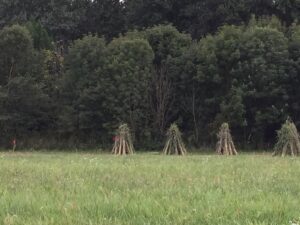
Year 3 (2019 season): We again planted Honey Drip variety, at a much lower rate by utilizing a custom made planter plate specifically made for this seed, which greatly reduced the multiple seed-drop that had been troubling us the past two years. Total planting on the Wise, Loomis, and Filler farms combined to slightly more than 1 acre. Expectations are that we will be able to harvest at least the same amount of cane as in year 2, and produce slightly more syrup.
Tools and equipment for planting and harvest: In Year 1, we used two different planters to help identify best seeding patterns to help reduce labor for cultivation during mid-summer, which is crucial for a profitable crop. Both pieces of equipment tended to release too many seeds per row resulting in the need to thin plants (optimal plant spacing is 5"-12" between plants). Space between rows varied from 30" to 36". We employed hand-thinning of rows and mechanical cultivation between the rows, and hand cutting vs. modified corn-bailing equipment for cane harvest. The agricultural intern and farm workers from ML-ELC and Old Loon Farm assisted with harvest at the Palmer Farm plots, which were larger in size. Organic cereal rye was sown as a cover crop on the plots after harvest.
To make improvements in Year 2, we planned to adjust the planting equipment and seed plates for better in-row seed spacing, and our Amish farmer consultant suggested using tapioca (as a dummy seed) mixed with the sorghum seed to promote spacing. We plan to thin plants very early in the growth process to 8" - 12". Spacing between rows will depend on the cultivation equipment each farmer chooses to use, some of which is shared cooperatively, at 30"-36". Plot size is dependent on the farmer's preferred use of equipment, available land, and labor available at critical cultivation and harvesting periods. We found that overall in Year 1, the intense time and labor associated with harvest, pressing, evaporation and finishing would severely limited our capacity for any increase in production of the syrup in Year 2. This became another challenge for our project.
Year 2 planting was completed in early June with the same 30" row planter for all plots. The planter was transported to each farm as soon as the ground was ready, and was completed in two days. Since we had trouble in year 1 with multiple seed drops with our planter, we cut the seed with pearl tapioca. Although not as problematic as in year 1, we still had to spend a significant amount of time and labor to thin plants in the rows to give the stalks room to grow to the desired girth. Early thinning in June was easier and more effective than later (July-August) thinning. Daikon radish - crimson clover mix was used as a cover crop on the plots post-harvest.
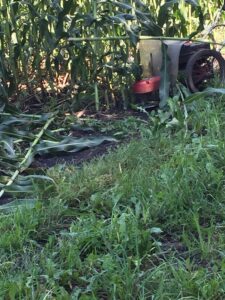 We tried several new techniques for harvest in year two, including a power cutter fabricated from a weed-wacker frame utilizing a saw blade. We also bundled the cane, used a chainsaw to cut the seed head off, and shocked cane in the field for drying rather than piling it into covered storage sheds until it could be transported for processing. Farmers agreed that the cutter was not as efficient as they had hoped, still requiring hand-gathering the stalks which fall in every direction. Stacking the cane in the field on wooden cradles made cutting the seed heads with a chainsaw easier, but was time consuming and probably not worth the effort. Plans for next harvest year include procuring a corn binder with an elevator to cut and bind the cane and place it directly onto the trailer used to transport it to the processor.
We tried several new techniques for harvest in year two, including a power cutter fabricated from a weed-wacker frame utilizing a saw blade. We also bundled the cane, used a chainsaw to cut the seed head off, and shocked cane in the field for drying rather than piling it into covered storage sheds until it could be transported for processing. Farmers agreed that the cutter was not as efficient as they had hoped, still requiring hand-gathering the stalks which fall in every direction. Stacking the cane in the field on wooden cradles made cutting the seed heads with a chainsaw easier, but was time consuming and probably not worth the effort. Plans for next harvest year include procuring a corn binder with an elevator to cut and bind the cane and place it directly onto the trailer used to transport it to the processor.
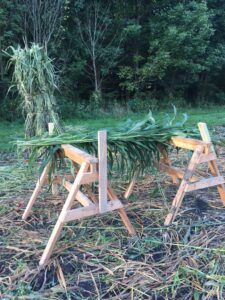 Year 3 planting was completed in early June with the 30" row planter utilizing a custom-made seed plate for the honey drip seed. No tapioca was used. Requirement for thinning between plants was much reduced and was completed as much as possible by early July. Cultivating and/or tilling between rows during the first two months helped to control weeds, although the very wet spring and summer kept the soil wet far into July. Growth seems to be uneven due to wet conditions, which have also affected corn, soybeans and vegetables in this area.
Year 3 planting was completed in early June with the 30" row planter utilizing a custom-made seed plate for the honey drip seed. No tapioca was used. Requirement for thinning between plants was much reduced and was completed as much as possible by early July. Cultivating and/or tilling between rows during the first two months helped to control weeds, although the very wet spring and summer kept the soil wet far into July. Growth seems to be uneven due to wet conditions, which have also affected corn, soybeans and vegetables in this area.
Tools and equipment for pressing, evaporation and finishing: In Year 1, as planned, we used cooperative labor and tools to process the sorghum cane into syrup. We pressed all the cane with Merry Lea Environmental Learning Center's (ML-ELC) antique press powered by an antique tractor. We also evaporated the juice to at least 220o at ML-ELC on their wood-fired evaporation unit. We were able to store the cooled, partially processed juice in plastic 5-gallon buckets at ML-ELC's walk-in cooler and use the ML-ELC produce facility to store and clean equipment for pressing and evaporation of the juice.
Due to the extended time frame for harvesting, we had an equally extended time frame for finishing and canning the final syrup product, which made the one-time rental of a commercial kitchen for finishing and canning unworkable. Therefore final finishing and bottling of the syrup was completed by Jane and Charlie Loomis at Old Loon Farm's kitchen facility over a period of several weeks between October 8 -31. We initially boiled the syrup product to 235o (Brix reading of ~78) outdoors over propane cookers, and then completed the final filtering and bottling on the stove top indoors. We used finishing equipment that is also used for maple syrup and/or honey production, including filters, refractometer, thermometers, and stainless steel pots. The total process took most of the month of October and produced an uneven product.
Data collection and information-sharing: We gathered information from regional producers and two of our partners attended sorghum festivals in Kentucky and Tennessee in late summer 2017. Problems with aphids and fungus are affecting crops in the southern US, but we have not had those problems with our crop in northern Indiana so far. We tracked seed varieties and soil types, as well as harvest and syrup production outcomes over the two plus growing seasons.
In early 2019 one partner-farmer registered for and attended the NSSPPA convention in Pigeon Forge, TN. The programming focus was beginning sorghum farming and he brought back more significant information to the group. He also submitted a jar of our 2018 product to the sorghum syrup competition which ranked in the top 50 submissions, and reported that we had the most "professional looking" label.
In Year 1, we shared information about our project with other local farmers through electronic media, handouts, farmer meetings, cooperative crop scouting, and a local sorghum festival held at the ML-ELC in mid-October. This effort generated interest and recruited one additional farmer to work with us in Year 2 of the project. Through meetings and mentoring, we helped the new producer select seed, plant, cultivate and harvest based on our findings from Year 1 of the project.
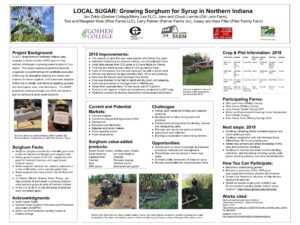 In March 2018, we shared our experience and network with other farmers at the Indiana Small Farms Conference (March 1-3) through general networking as well as a poster presentation by the agro-intern about our project. Our proposal to present our project at the 2019 Indiana Small Farms Conference was not accepted, but the cooperating farmers utilized another poster presentation (see photo at left) which included free samples of the syrup and value added products, and was very well received. Contacts from this presentation were followed up with our sales person in the spring and summer.
In March 2018, we shared our experience and network with other farmers at the Indiana Small Farms Conference (March 1-3) through general networking as well as a poster presentation by the agro-intern about our project. Our proposal to present our project at the 2019 Indiana Small Farms Conference was not accepted, but the cooperating farmers utilized another poster presentation (see photo at left) which included free samples of the syrup and value added products, and was very well received. Contacts from this presentation were followed up with our sales person in the spring and summer.
Marketing the Sweet Sorghum Syrup: Our goal is to produce a superior syrup that is standardized across the cooperating farms, and to market it regionally at farmers markets, restaurants and breweries. We commissioned a graphic artist to design a label that would promote a single product name but allow individual farmers to market themselves as well. This resulted in the Indiana Natural label that has space to identify the individual farmer's contact information. The labels are designed for Avery weather-resistant shipping labels, and can be printed in any quantity at our local print store at a much more reasonable price than ordering large quantities of pre-printed labels. Our research indicated that we were not required to include nutritional information on the label, so for this year, we employed a very simple label format.
After unsuccessfully searching for an appropriate marketing coordinator over the first 6 months of the project and nearing the deadline for our first event, we contracted with a local writer to help us produce press releases, hand outs, and on-line event announcements to work with us for our 2017 fall festival. For marketing our sorghum syrup, we realized that each cooperating farmer had many local business contacts in the region, and that we could continue to contact local outlets and distribute product and price information over the fall and winter season. Through 2018, we had not hired a professional marketing coordinator, but we sold our sorghum syrup at local farm markets, and distributed product and a pricing sheet to local chefs and restaurants, food businesses and brewers, requesting they sample our product and give us feedback. This effort to expand the market continued throughout Year 2, with hiring of a marketing coordinator remaining an option.
Beginning in April, 2019 we hired a part-time salesperson to visit local markets and investigate inclusion of our product in Indiana markets and fairs. Since our product is grown and produced in Indiana, we are also utilizing the Indiana Grown label on our product label.
Our marketing efforts in 2018-19 included introductory and sales trips by our salesperson and partner-farmers to various locations across our region, including several breweries and brew clubs, at least one distillery, one cider mill, quite a few restaurants and caterers, several specialty retail outlets, several farmers markets/ holiday bazaars, and a couple of "foodie" organizations. We participated in workshops; we distributed promotional information about sorghum, as well as complimentary jars of the product and business cards, at these locations. There seems to be a strong interest in the product as many people remember their grandparents or parents using the syrup, but do not see it locally available in stores. Sales at farmers markets have been reasonable; we have interest in bulk product from a distiller who is interested in making "local" rum. Through 2018 and 2019 we piloted marketing value-added products, including sorghum caramel corn (quite popular), sorghum cookies, sorghum cake, and sorghum peanut brittle. We are also experimenting with a sorghum based BBQ sauce, and are planning to age some of our 2019 product in whiskey barrels to produce another profitable, value added product.
Our biggest challenge in Year 1 was the time and labor crunch surrounding harvest and processing of the syrup. The Merry Lea equipment proved to be great for an educational demonstration, but the ML-ELC is not appropriate for the long term or for bulk pressing and evaporation over a sustained period. We learned a great deal about timing and the limits of our production capacity based on the critical harvest and syrup processing window, and realized that farmers would soon abandon sweet sorghum production unless the process could be streamlined. Therefore we began searching for alternatives to producing the syrup "at home."
We located an Amish farmer in Middlebury, Indiana, who operates a finishing plant (Heritage Acres) for cane sorghum. This operation is not unlike the major producers in the southern US, or for that matter, historical production in our area where farmers took their cane to a central processing site to be made into syrup. The facility uses a steam evaporation/cooking process and bottles the finished syrup onsite. Choosing to have our cane processed at this facility would require us to harvest our cane during a specific, short window of time around the end of September, and to haul the harvested cane on trailers approximately 36 miles one way. The facility would chop, press, evaporate and bottle our syrup at a price that would have to be covered by our wholesale and retail sales. We could still market our product under our own cooperative label.
Utilizing the finishing operation facility would solve several problems that we encountered in Year 1: 1) It would allow us to utilize the ML-ELC for use as a demonstration/educational festival site without overtaxing the staff or making major improvements to their existing facilities; 2) It would significantly decrease the labor commitment required of the individual farmers in the finishing and bottling process, allowing us to increase production and output of the syrup product, as long as we could handle the labor required for growing and harvesting; 3) it would standardize our product. These are major issues that directly affect our quality of life.
Utilizing the finishing operation facility would also affect our scheduling on the planting side: 1) we would need to standardize the seed variety(ies) so that we produced a uniform crop that could be planted early enough to ensure harvest by late September, and one that would resist lodging, increasing our yield; 2) we would need to coordinate our cooperative labor to harvest, pack and transport our cane to the processing plant at the appropriate time; 3) we would need to determine the appropriate plot size, crop yield, and market price of the syrup to profitably cover the cost of processing; 4) we would need to save enough harvested cane to provide material for the educational demonstration/outreach event at Merry Lea ELC in October, as well as have syrup product for tasting and sale at the festival.
We have learned over the course of the project so far, that central processing is a common way that sorghum is and has historically been produced. Individual processing is possible and sustainable for a small amount of syrup production, but fails to support production of larger quantities for retail or wholesale. The cooperating farmers agreed that central processing with Heritage Acres would be an appropriate change for Year 2 for our project.
We found at least two additional farmers interested in production of sorghum syrup for the 2018 season, with one following through and joining the cooperative effort. We planned to support their inclusion in the group by: 1) information sharing, physical assistance in growing, cultivating and harvesting the crop; 2) providing seed for crop and cover crops; 3) sharing planting, cultivating and harvesting equipment; 4) providing individualized labels for their syrup product. In return, the new farmer is to 1) assist with group planting, cultivation and harvest; 2) share agronomic information regarding their plots; 3) assist with marketing and promotion of the syrup product; 4) assist with outreach events.
Extension of Project to Year 3: In November of 2018 we asked to have the project extended into the 2019 growing season. This afforded us a third planting and growing season, as well as extended our time for public outreach and marketing.
Year 2 (2018 season) incorporated several changes. Changes to the planting and processing resulted in a better harvest, and a more palatable and consistent syrup product, with output increase from approximately 20 gallons to 97.5 gallons.
We again supported the field day/sorghum syrup demonstrations at the Merry Lea Environmental Learning Center but held a separate outreach educational event for interested farmer/growers and potential markets. The luncheon meeting was held in Goshen, IN at Anna's Bread restaurant near the Goshen Farmers Market, featured our Amish producer/processor as the main presenter, and drew 16 interested potential growers/consumers, a local newspaper columnist, and potential markets. As in the 2017 farmer's meeting, we used this opportunity to highlight foods made with sorghum syrup as well as to distribute our product to restaurants, breweries and coffee houses in the area.